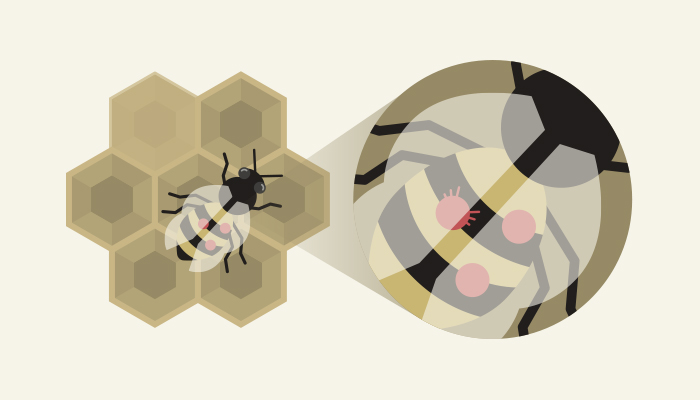Stories | July 13, 2017 | Read Time: 5 minutes
The Great Honey Bee Venture
The brightest minds in the world of honey bees are searching for answers. The origin of this quest connects back to a problem plaguing every colony in North America. Aptly named, “Varroa destructor,” this pervasive parasite is one of the most significant contributors to the challenges facing honey bees. As beekeepers throughout the U.S., Canada, and Mexico can attest, if any hive is fortunate enough to live without the Varroa mite, they will not enjoy this freedom for long—infestation is merely hours away. Considering they pollinate nearly one-third of the global food supply, any challenge facing honey bees is shared with humanity.
The Varroa mite is the number one threat to honey bees in North America.
In response, leaders throughout modern agriculture, academia, and government are investing time, money, and intellect to provide relief to honey bees. This collective effort is an example of the long-standing commitment to biodiversity by farmers, scientists, and other conservationists. Through various areas of inquiry, a remarkable team of researchers are working to ensure the honey bee remains a robust part of modern agriculture and the ecosystem.

Varroa attach themselves to the outer anatomy of honey bees.
Varroa attach themselves to the outer anatomy of honey bees.
Defending the Hive
In 2012, Monsanto acquired Beeologics, a small company based in Israel. Our leadership saw great potential in their research; in particular, the work focused on helping beekeepers control negative pests. These ingenious researchers were using a sweet syrup and a Nobel prize winning discovery they hoped would lead to a safer method of controlling Varroa mites.
This groundbreaking research has matured to Phase 3 of our research and development pipeline. Expected to be under the umbrella of BioDirectTM Technology, our researchers continue exploring how a naturally occurring process called, “RNA Interference,” can be developed into a product that could help honey bees resist infestation.
“The appeal of this approach is the ability to target just the Varroa mite, while reducing or eliminating the use of chemical pesticides in honey bee colonies.“ —Dr. Jerry Hayes, Monsanto Honey Bee Health Lead
In the larva stage, honey bees are particularly vulnerable to Varroa. This point in the honey bee’s development also provides easy access to the Varroa mite—true to the nature of parasites, whatever is ingested by the honey bee larvae is also consumed by the Varroa mite. With this in mind, Monsanto’s product in development will be added to larval food, metabolized and enter their bloodstream where finally, any Varroa attached to the honey bee enjoys a final stolen meal.

Some honey bees enter adulthood with Varroa already attached. This causes deformity and the spread of viruses.
Some honey bees enter adulthood with Varroa already attached. This causes deformity and the spread of viruses.
At present, the products used to treat a Varroa-infested hive cannot discern between a harmful mite and a helpful honey bee. We believe a more refined and targeted alternative is needed—a method that empowers beekeepers to apply fewer of these products, less often. To provide this more precise alternative, a more intimate knowledge of both honey bees and Varroa mites is required. Advanced genetic sequencing software is helping decode the DNA of honey bees and Varroa to help create a new product that remains innocuous to honey bees, while being an effective control for Varroa mites.
Wisdom from the Academy
As what is often the case in science, universities are providing invaluable primary research. The University of Florida is building a considerable base of knowledge on the biology behind the Varroa mite challenge. In order to find a solution, you must first understand the problem itself.

Visiting honey bees from infected colonies can unintentionally spread Varroa.
Visiting honey bees from infected colonies can unintentionally spread Varroa.
Varroa Reproductive Behavior
One fascinating area of inquiry underway in The Sunshine State is researching how Varroa invade hives prior to reproducing. It is believed that understanding this process, will help illuminate how Varroa develop a resistance to acaricides—a substance often used to control the parasite.
Building the Bee Lab
The University of Florida is also in the process of fundraising for a dedicated honey bee research lab. The Honey Bee Research and Extension Laboratory will serve as the center for the university’s efforts to better understand this pollinator and share their findings with students, beekeepers, and other conservationists.

Researchers monitoring the presence of Varroa in a field trial.
Researchers monitoring the presence of Varroa in a field trial.
Insights from Government
The research arm of the USDA, the Agricultural Research Service (ARS), has a number of honey bee and Varroa mite related projects. Their labs have begun breeding pests for testing and exploring natural or alternative controls. Other avenues of Varroa research include investigating how factors like humidity or the presence of essential oils influence colony health. Many throughout beekeeping, modern agriculture, and the scientific community look forward to the insights borne from these projects. Government-funded research has historically lead to countless important breakthroughs.
Honey bee health and biodiversity are rightfully on the minds of many today. The challenges facing these essential pollinators are bigger than one company, organization, or institution. For this reason, Monsanto is honored to join the cause of improving the wellbeing of honey bees. Our search is a true commitment. For the betterment of the hive, beekeeper, farmer, and consumer. As the honey bee thrives, so do we.









